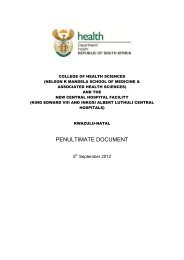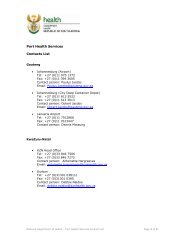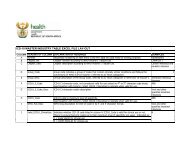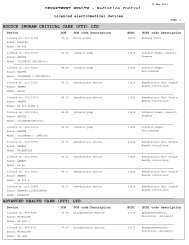i) Inspecting premises <strong>to</strong> ensure compliance with safety, s<strong>to</strong>rage <strong>and</strong> other precaution measures;j) Ensuring sampling is done according <strong>to</strong> approved procedures;k) Ensuring all labelling regulations are complied with;l) Checking all s<strong>to</strong>ck records <strong>and</strong> ensuring the hazardous substance register is up <strong>to</strong> date;m) Ensuring that empty, containers are disposed of according <strong>to</strong> statu<strong>to</strong>ry requirements.These norms <strong>and</strong> st<strong>and</strong>ards aims <strong>to</strong> assist in providing a national approach <strong>and</strong> guidelines <strong>to</strong><strong>Environmental</strong> <strong>Health</strong> Practitioners (EHPs) in the provision of chemical safety <strong>and</strong> hazardous substancescontrol, ensure the sound management of chemicals <strong>and</strong> ensure protection of human health <strong>and</strong> theenvironment.2. The scope of applicabilityThese norms <strong>and</strong> st<strong>and</strong>ards on hazardous substances <strong>and</strong> chemical safety shall apply <strong>to</strong> the following:• Importers, manufacturers, wholesale distribu<strong>to</strong>rs, registered pharmacists, general dealers, farmers,industries <strong>and</strong> fac<strong>to</strong>ries, retailers (formal <strong>and</strong> informal), pest control opera<strong>to</strong>rs, business premises,schools, labora<strong>to</strong>ries, public <strong>and</strong> private premises, work <strong>and</strong> home places.• All Group I hazardous substances premises <strong>and</strong> dealers shall be inspected for compliance <strong>and</strong>licensing in terms of the Hazardous Substances Act, 1973 (Act No. 15 of 1973) <strong>and</strong> the Group Ihazardous substances Regulations.• All consignments of Group I hazardous substances shall be inspected prior <strong>to</strong> release <strong>to</strong> licensedpremises.• This norm <strong>and</strong> st<strong>and</strong>ards excludes electronic products <strong>and</strong> radioactive substances as well asexplosives.3. Roles <strong>and</strong> Responsibilities of EHPs in role players in hazardous substance control <strong>and</strong>chemical safety management3.1 Department of <strong>Health</strong>EHPs at Provincial level must:• Overall responsibility <strong>to</strong> support <strong>and</strong> oversee issues pertaining <strong>to</strong> hazardous substances <strong>and</strong>chemical safety in the province.• Moni<strong>to</strong>ring <strong>and</strong> evaluation of the implementation of hazardous substances control in the province.• Enforcement <strong>and</strong> compliance in terms of hazardous substances control.• Issuing of licenses in terms of the Hazardous Substances Act, 1973 (Act No. 15 of 1973).EHPs at Municipality level must:• Issuing of permits in terms of the relevant by-laws.• Enforcement <strong>and</strong> compliance in terms of chemical safety issues.• Moni<strong>to</strong>ring <strong>and</strong> evaluation of the chemical safety issues in their jurisdiction.3.2 Department of <strong>Environmental</strong> Affairs3.3 Department of Transport3.4 Department of Labour3.4 Other stakeholders• Assist <strong>and</strong> support in the enforcement, compliance, moni<strong>to</strong>ring <strong>and</strong> evaluation of hazardoussubstances control <strong>and</strong> chemical safety issues in the country.• Assist <strong>and</strong> support with awareness campaigns <strong>and</strong> projects; information, education <strong>and</strong>communication (IEC) materials <strong>and</strong> research <strong>and</strong> development.NORMS1. The use, h<strong>and</strong>ling, s<strong>to</strong>rage <strong>and</strong> disposal of hazardous substances <strong>and</strong> the control of chemicals safety<strong>to</strong> be in line with the requirements of the Hazardous Substances Act, of 1973.2. Hazardous substances dealer’s premises <strong>to</strong> be operated under a license issued by an EHP <strong>to</strong> theeffect that the premises comply with the environmental <strong>and</strong> occupational hygiene requirements.DOH. <strong>Norms</strong> <strong>and</strong> st<strong>and</strong>ards for environmental health in South Africa Feb 2013 136
3. The premises used in connection with the h<strong>and</strong>ling, s<strong>to</strong>rage, use or disposal of hazardoussubstances <strong>and</strong> chemicals <strong>to</strong> in compliance with the provisions of the Occupational <strong>Health</strong> <strong>and</strong> SafetyAct 2003, (Act no 85 of 2003).4. The premises in compliance with the requirements of the <strong>National</strong> Building Act <strong>and</strong> the <strong>National</strong>Building Regulations, act 103 of 1977, <strong>and</strong> conforms <strong>to</strong> the specifications of the SANS 10400,application of the <strong>National</strong> Building Regulations.5. Potable water <strong>and</strong> sanitation services available within 200m of the premises.ENVRONMENTAL HEALTH MONITORING STANDARDS1. <strong>Environmental</strong> health inspections of hazardous substances dealer’s premises should be conducted atleast twice (2) a year. The risk profile of the premises should inform the frequency of inspections ofspecific premises.2. Inspections should include the assessment of aspects such as ventilation, indoor air quality, lighting,moisture-proofing, thermal quality <strong>and</strong> structural safety.3. Inspection checklists should be designed <strong>and</strong> utilized during all inspections <strong>to</strong> guide <strong>and</strong> ensurecomplete assessment. An inspection report, indicating the conditions of the premises as well as therecommendations applicable, should be provided <strong>to</strong> the owner or person in charge after everyinspection.4. <strong>Health</strong> education should form an integral part of all environmental health compliance moni<strong>to</strong>ringinspections.5. A risk assessment of hazardous substance dealers premises should be conducted by an EHP <strong>to</strong>assess conditions on the premises that may pose a threat <strong>to</strong> the health, safety <strong>and</strong> welfare ofchildren, by:• Identifying hazards on the premises;• Assessing the likelihood of the hazard posing a risk <strong>to</strong> the employees on the premises or thegeneral public;• Estimating the severity of the consequences, if harm is caused; <strong>and</strong>• Recommending action plans <strong>to</strong> child care centre management <strong>to</strong> eliminate the hazard orminimise its effect through control measures.6. The risk analysis should be done with specific focus <strong>to</strong> the following areas:• The use <strong>and</strong> h<strong>and</strong>ling of hazardous substances;• S<strong>to</strong>rage of substances;• Transportation of substances; <strong>and</strong>7. Inspection checklists should be designed <strong>and</strong> utilized for every inspection conducted. <strong>Environmental</strong><strong>Health</strong> requirements for day care centers (discussed below) should be used as guide for developingof inspection checklists.8. An inspection report, with the risk assessment findings <strong>and</strong> recommendations should be issued <strong>to</strong> theowner or person in charge of the day care center after every inspection.9. An inven<strong>to</strong>ry of hazardous substances premises (both registered <strong>and</strong> unregistered) in a municipalityconcerned, should be maintained for moni<strong>to</strong>ring <strong>and</strong> control purposes.10. Moni<strong>to</strong>ring of child care centers should be coordinated with all other relevant stakeholders, such asSocial development, Basic Education <strong>and</strong> Primary <strong>Health</strong> Care, <strong>to</strong> ensure synergy, comprehensiveprovision of services <strong>and</strong> proper referral of issues where necessary.STANDARDSSECTION 1: REQUIREMENTS FOR HAZARDOUS SUBSTANCES DEALER PREMISES1. License / Permita) In terms of the Hazardous Substances Amendment Act 15 of 1973, all importers, manufacturers,whole distribu<strong>to</strong>rs, registered pharmacists, general dealers, farmers, industries <strong>and</strong> fac<strong>to</strong>ries, retailers(formal <strong>and</strong> informal), pest control opera<strong>to</strong>rs, business premises, schools, labora<strong>to</strong>ries, public <strong>and</strong>private premises <strong>and</strong> workplaces must be licensed/permitted on hazardous substances <strong>and</strong> chemicalsafety issues where applicable. The license shall not transferable from one person or owner <strong>to</strong>another.DOH. <strong>Norms</strong> <strong>and</strong> st<strong>and</strong>ards for environmental health in South Africa Feb 2013 137
- Page 1 and 2:
No. 36849 GOVERNMENT GAZETTE, 20 SE
- Page 3 and 4:
AcknowledgementsDrafting Team (Nati
- Page 5 and 6:
Preamble by Director-GeneralThe Nat
- Page 7 and 8:
POLICY AND LEGISLATIVE FRAMEWORKThe
- Page 9 and 10:
1. Introduction1.1 Policy contextOn
- Page 11 and 12:
5. Monitoring and enforcing complia
- Page 13 and 14:
BACKGROUNDHealth surveillance of pr
- Page 15 and 16:
h) Adequate and potable water avail
- Page 17 and 18:
a) Entrance and exit control must b
- Page 19 and 20:
• Storage of unsafe, toxic, dange
- Page 21 and 22:
(i) For children between 0-24 month
- Page 23 and 24:
• The health certificate holder,
- Page 25 and 26:
a) Separate storage facilities must
- Page 27 and 28:
2.4 Inspections should include an a
- Page 29 and 30:
g) Adequate facilities must be prov
- Page 31 and 32:
d) Corridors must be at least 1.8m
- Page 33 and 34:
1. NORMS1.1 Schools to be operated
- Page 35 and 36:
• A cardiopulmonary mouthpiece pr
- Page 37 and 38:
a) All circumcisions must be conduc
- Page 39 and 40:
) Toilets, wash hand basins and bat
- Page 41 and 42:
• Liquid soap;• First aid instr
- Page 43 and 44:
h) A daily record must be kept on t
- Page 45 and 46:
t) A separate room or area with sep
- Page 47 and 48:
h) An adequate number of purpose-ma
- Page 49 and 50:
c) Health care facilities should ha
- Page 51 and 52:
a) All facilities used in connectio
- Page 53 and 54:
5. General hygiene requirementsa) T
- Page 55 and 56:
1.1 The premises operated under a v
- Page 57 and 58:
5. Environmental health should cond
- Page 59 and 60:
d) The use of non-waterborne sanita
- Page 61 and 62:
so many kgs of manure is produced p
- Page 63 and 64:
a) On any residential premises, onl
- Page 65 and 66:
n) A rodent-proof storeroom must be
- Page 67 and 68:
d) Pets must be vaccinated against
- Page 69 and 70:
1.3 The premises in compliance with
- Page 71 and 72:
2.1 Environmental health inspection
- Page 73 and 74:
2.1 Environmental health inspection
- Page 75 and 76:
1) Responsibility of management1.1.
- Page 77 and 78:
that all possible health impacts of
- Page 79 and 80:
BACKGROUNDThe Scope of Profession o
- Page 81 and 82:
a) An Integrated Disease Surveillan
- Page 83 and 84:
a) All food onboard must be stored
- Page 85 and 86: 3. Waste managementa) The managemen
- Page 87 and 88: c) Documents outlining prevention,
- Page 89 and 90: Chapter 3HEALTH RELATED WATER QUALI
- Page 91 and 92: d) The catchment (rivers, treatment
- Page 93 and 94: f) Ensuring monitoring of effective
- Page 95 and 96: SECTION 4:WATER QUALITY MONITORING
- Page 97 and 98: water world etc)1. In the event of
- Page 99 and 100: Step 2: if water is obtained from t
- Page 101 and 102: • Of the time frame, if any, with
- Page 103 and 104: 3. Household grey-water (generated
- Page 105 and 106: SECTION 14:MONITORING OF DRINKING W
- Page 107 and 108: contamination (e.g. from birds and
- Page 109 and 110: SECTION 21: COMPLIANCE ENFORCEMENT6
- Page 111 and 112: DEFINITION OF APPLICABLE TERMSThe f
- Page 113 and 114: BACKGROUNDWaste management is the c
- Page 115 and 116: • Provides municipal health servi
- Page 117 and 118: a) The premises used for recycling
- Page 119 and 120: SECTION 4: COLLECTION OF GENERAL WA
- Page 121 and 122: SECTION 7: CLASSIFICATION, PACKAGIN
- Page 123 and 124: • The spillage area shall be mark
- Page 125 and 126: • Elbow length heavy duty gloves,
- Page 127 and 128: anatomical waste anatomical • Hav
- Page 129 and 130: • Waste oxidizing substances and
- Page 131 and 132: Sharps container 90 days Cool room
- Page 133 and 134: Relationships between transboundary
- Page 135: Chapter 5HAZARDOUS SUBSTANCES AND C
- Page 139 and 140: d) In addition, all hazardous subst
- Page 141 and 142: 4. Guidelines for Drinking Water Qu
- Page 143 and 144: for conducting monitoring.7. Analyz
- Page 145 and 146: Bacterial infectionsCholeraCampylob
- Page 147: paralytic aspeticmeningitis. The re


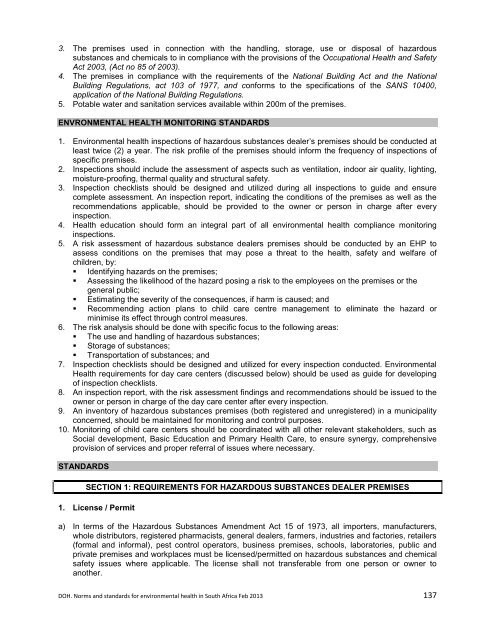
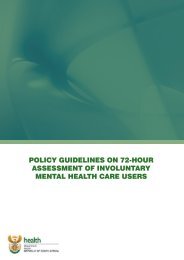


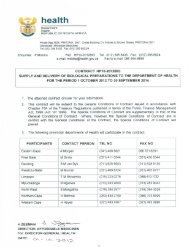
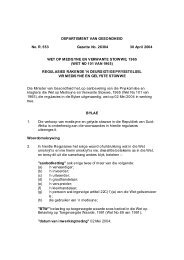
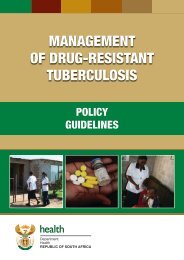
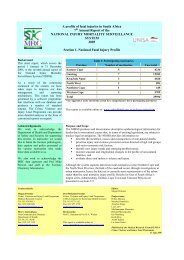
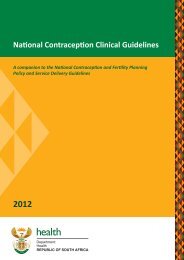
![A monograph of the management of postpartum haemorrhage [2011]](https://img.yumpu.com/15578784/1/184x260/a-monograph-of-the-management-of-postpartum-haemorrhage-2011.jpg?quality=85)
